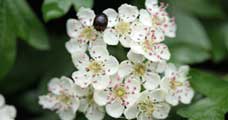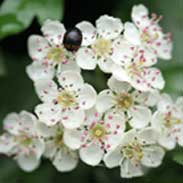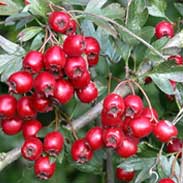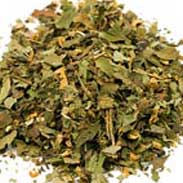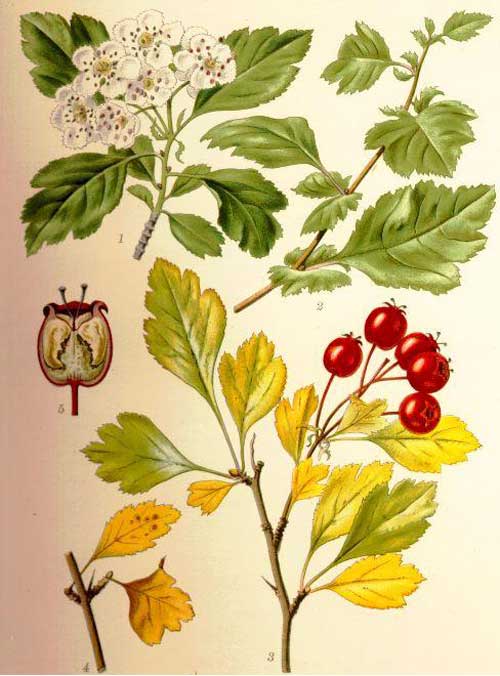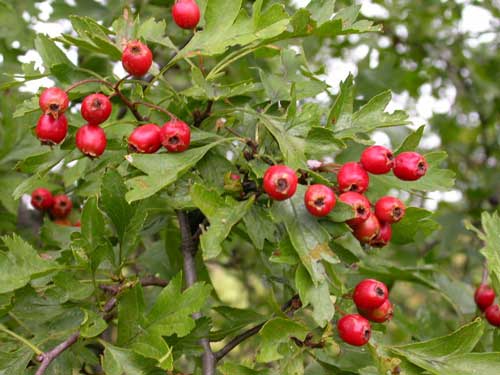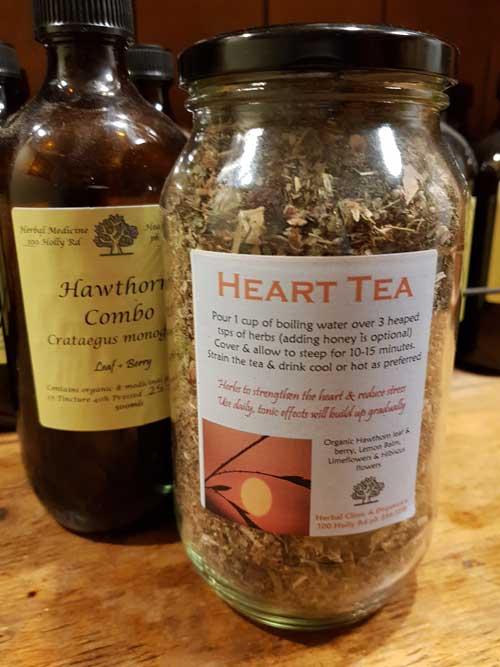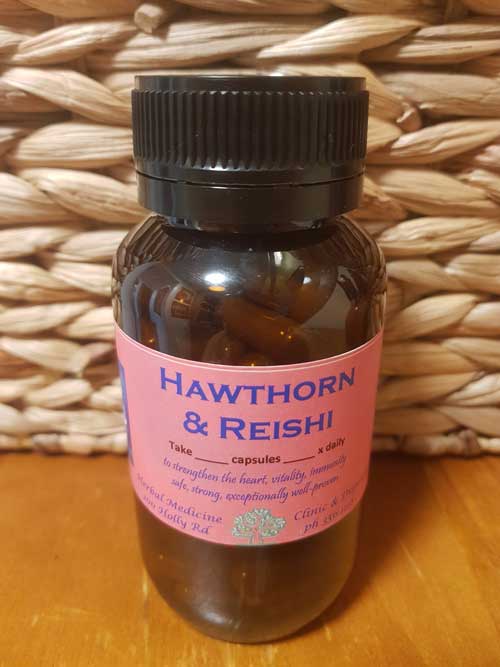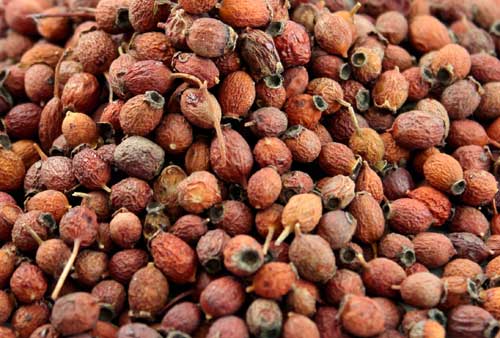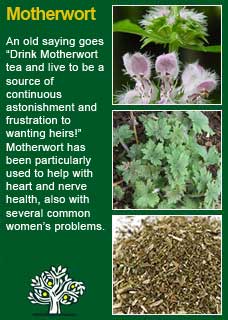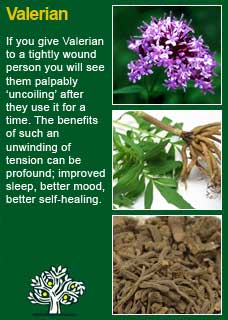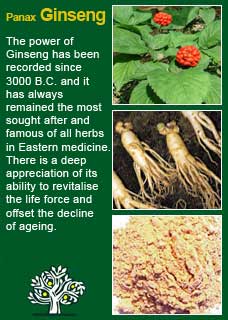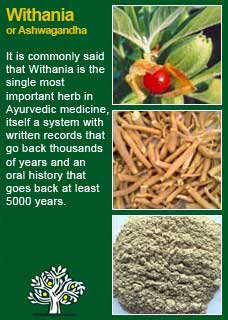
|
|
||||
| Our Pages ABOUT CONSTITUTIONAL MEDICINE
|
The flowers, leaves and berries of Hawthorn which are all highly regarded for their therapeutic benefits and are abundantly produced every year by strong, long-lived Hawthorn trees.
Hawthorn has a marvellous folk-history as a heart remedy and restorative and modern studies fully bear out its traditional reputation. This is a fact, without increasing blood pressure or producing any other kind of strain, Hawthorn increases blood flow through the heart and strengthens the heart muscle. Hawthorn can help:
The British Herbal Pharmacopoeia (BHP) describes the actions of Hawthorn as 'cardiotonic, coronary vasodilator, hypotensive, reputed to dissolve deposits in thickened & sclerotic arteries'. It says it is indicated for 'cardiac failure, or earlier myocardial weakness, hypertension, arteriosclerosis, paroxysmal tachycardia' and specifically indicated 'hypertension with myocardial weakness, angina pectoris' The BHP recommends a dose of 0.3-1gm or by infusion and the tincture at 1:5 in 45% ethanol at a dose of 1-2 mls. Thomas Bartram writes that the actions of Hawthorn include 'positive heart restorative, coronary vasodilator, antispasmodic, antihypertensive, adaptogen, diuretic, sedative to nervous system, cholesterol and mineral solvent. Action lacks the toxic effects of digitalis; useful where digitalis is not tolerated'. Sharol Tilgner writes 'Hawthorn is not used for acute illness. It is an adaptogen specific for the circulatory system and is used in numerous circulatory system problems. It is a slow acting, nourishing plant which needs to be taken for long term for best effects, 3 months or more. David Hoffmann writes 'a tonic in the true sense, Hawthorn can be considered a specific remedy for most cardiovascular disease. A whole plant preparation should be used, as the individual effects of isolated constituents proved insignificant when tested in the laboratory. The whole plant, on the other hand, has unique and valuable properties. Hawthorn's primary attribute appears to be an ability to improve coronary circulation. It dilates the coronary arteries, relieving cardiac hypoxemia. Consequently, it reduces the likelihood of angina attacks and relieves symptoms of angina when they occur. The herb thus directly affects the cells of the cardiac muscle, enhancing both activity and nutrition.
Hawthorn has been the subject of a great deal of scientific research. The New York Heart Association (NYHA) classifies loss of cardiac function as stage 1; the patient is symptom free when at rest and taking treatment and at stage 2 when also on treatment but losing heart capacity with medium amounts of effort. ~ A meta-analysis involving 8 clinical trials using Hawthorn extracts showed consistently and significant positive effects for patients who were mostly NYHA stage 2 (Loew D. Der Kassenarzt, 1994; 15:43-52) ~ In a randomised, double-blind, placebo-controlled study. Hawthorn extract administered for 12 weeks increased exercise tolerance in patients with NYHA stage 2 congestive heart failure. The placebo group showed worsening results. No adverse reactions were reported in the Hawthorn group (Zapfe jun. G: Phytomed 8(4)252-266, 2001) ~ Significant benefit in cardia parameters was achieved in a multi-centre, double-blind, placebo-controlled trial using Hawthorn leaf and berry extract in 80 patients with mild congestive heart disease resulting from ischemia or hypertension. No adverse interactions with conventional medicines were observed (Iwamoto M, Ishizaki t, Sato T. Planta Med 1981; 42(1):1-16) ~ In a randomised, double-blind, placebo-controlled study, Hawthorn extract significantly increased heart rate variability (HRV) in geriatric patients compared with placebo. Low HRV is a risk factor in coronary heart disease and a positive correlation exists between HRV and life expectancy (Rudoplh HT, Erben C, Buhring M. International Congress on Phytotherapy, Munich, September 10-13, 1992) ~ In a randomised, double-blind, placebo-controlled clinical study, Hawthorn extract for three weeks was found to improve pathology in patients with angina pectoris (Hanack t, Bruckel MH, Therapiewoche 1983; 33:4331-4333) ~ In a surveillance study Hawthorn extract was shown to be well tolerated and improved the symptom score on average by 66.6% in patients with heart disease (NYHA stage 1 & 2). Clinicians rated overall efficacy as better than 90%. Patients with borderline hypertension, tachycardia and cardiac arrhythmias exhibited excellent results, with blood pressure, heart rate and incidence of arrhythmias being reduced (Schmidt U, Albrecht M, Podzuweit H et al. Z Phytother 1998; 19:22-30) ~ A four year study commissioned by the German Ministry of Health, found that it improves contractions in the veins and heart while dilating the heart. (Hoffmann 1995). ~ In a clinical trial with 78 patients with congestive heart failure, hawthorn increased heart working capacity, lowered blood pressure and improved fatigue and endurance while relieving difficult breathing (Schmidt, et. al. 1994) ~ A clinical trial with 46 patients decreased the number of angina attacks by 85% (Chang 1986). ~ A clinical trial with 18 healthy patients found that hawthorn lowered heart rate and blood pressure during exercise and maintained resting heart rate (Hellenbrecht 1990). ~ Laboratory and clinical trials have reported that hawthorn lowers cholesterol and triglycerides by improving excretion ~ There are over 120 published studies and articles on Hawthorn, a PDF showing their titles, authors and when and where they were published can be found here
For some years now, against this proven and safe way of herbalism, there has been a rising tide of excessive caution and scare-mongering in many parts of the world. The same authorities that, not so long ago, decried herbal medicines as ineffectual, have now taken up a different adversarial position; that they are dangerous substances that should only be prescribed by Doctors, who of course have zero training in them. Unfortunately, the same unnecessary fear and worry has crept into many natural health websites and popular publications on herbs. Herbs that we have safely used for thousands of years, that have no reports of adverse reactions in the medical literature despite widespread use by millions of people, are suddenly described as contraindicated because of something that should have been seen as completely unimportant, or at the utmost a merely theoretical concern, such as a laboratory study on one of the herb's constituents to use an all too common example. I wonder sometimes if the writers of such articles feel that the herb will be more deserving of respect if it is thought to be a little bit dangerous, in other words more like a drug than something that has simply come out of the earth and been used by ordinary people for generations beyond count. There is just so much misinformation about herbal medicine on the internet now. Ludicrous claims and cautions abound in equal measure; it seems like one group are trying to make money out of the public whilst the other are busily trying to scare them off. I have to believe that the kind of reader who takes the time to read pages on herbs that are as extensive as this one is much less likely to be swayed by marketers or misinformers. I hope that you will keep your wits about you if you get conflicting opinions from people who have never really got to know these herbs, who have never worked with them, or learned how to use them safely and effectively. I want to remind you that the reason that herbs can never be patented and owned by any individual or corporation is because they are, and always will be, the People's medicine. They belong to all of us and it is my great hope in sharing this work that you will learn how to use them wisely for yourself, and the people you care for. Be safe, but do not be afraid.
We have a large and flourishing Hawthorn tree right at the corner of our clinic entrance. It is the first thing you see all year round when you come in, and then it fills with beautiful pink blossoms every spring followed by equally abundant berries in the autumn. I warmly encourage anyone with any kind of heart problem, and those who know they have a weakening heart from simply growing older, to find out what an extraordinary ally Nature has given us with this great healing herb. I am sure that all herbalists who regularly use Hawthorn grow to love this plant for how reliably and well it helps. Hawthorn is one of the herbs that I personally use the most in my work and I am certain that I have many patients who are alive and well today because of it. With an electronic stethoscope that records directly to a computer, I carefully make several recordings of the heartbeats of most of my patients when I first meet them. This is especially helpful for anyone who has any kind of heart irregularity such as arrythmias, fibrillations, murmurs etc. because then you can accurately compare a later reading with an earlier one. However, for many other people, much more common than a medical heart condition is that they simply have a tired heart. If you stay alive for long enough then you will eventually get old and, for many people, it is their heart that wears out the most. Anyone could hear this if they were to tune their ear to people and listen carefully to enough people's hearts. Young and healthy hearts are like spring lambs, they practically leap out of their chests but the more worn out a person becomes, the more tired their heart sounds. This is why I feel such a deep sense of gratitude towards Hawthorn. I know that it doesn't matter how tired and worn out a person heart sounds, if I give them a decent dose of Hawthorn for long enough it will sound better, very often it will sound quite remarkably better, the heart sounds steadier in its rhythm, stronger in its beat. You can hear and sense that it has helped some of their life force, their vitality, to return. And of course, they are then usually reporting that they have more energy, they are able to spend more time with other people, or in their garden, or out walking etc. If you who are reading this are studying herbal medicine, or have your own personal reasons to need to know this great plant ally more closely, then I recommend you take a small dose of Hawthorn (leaf, berry or both) in a tea or tincture and then listen closely to what your body has to tell you. For many people, especially when they are ready for a heart tonic, these is a noticeable, palpable warmth and well-being that suffuses through the system after just a few moments. Try for yourself and see! Further to this, if you would like to learn more about the ancient art of pulse testing, a simple but powerful way to ask the intuitive intelligence of the body for its responses to a herb by feeling the pulse whilst giving a tiny dose by mouth, read here Dosage is always a critically important part of herbal medicine and getting the right dose is frequently what makes or breaks a successful treatment. I don't think there is one exact right level to use Hawthorn for everyone but if using this precious herb to help nourish an ageing or weakened heart back to strength then I would recommend quite robust doses, e.g. as much as 3 or 4 mls in a day of a combination of the extracts of both the leaves and the berries or 4 capsules of the concentrate of Hawthorn berries that we use (combined with Reishi mushroom in a product we get made up for our clinic and pictured below) which equates to about 3 grams of the dried herb per day. Hawthorn combines beautifully with Motherwort for irregular heartbeats, with Valerian for any kind of cardiac stress or blood pressure type problems and with Panax Ginseng and Withania for a tired or weakened heart. As well as its proven and profound physical benefits, I am personally quite certain that Hawthorn helps people who have suffered from pain and suffering at an emotional level and have something of a broken heart. Perhaps from loss, perhaps from loneliness, perhaps even from betrayal. Certainly, there can be an ache there that is every bit as real as any physical heart condition. For such uses, I will typically combine it with a small dose of Arnica, and I am sure that the combination of Hawthorn and Arnica work together to help healing journey in 'wounded heart' in a way that could never happen without their support. That said, of course, the patient has to take their own steps too and this important but tricky subject is somewhat tackled in the chapter on emotional healing found here. I don't think you need such robust doses of Hawthorn when using it for emotional healing and would be happy to use as little as 20 drops a day or even less of it in that capacity, but there are no hard rules about such things, every case is different and there is a lot to be said for bringing an open mind and a willingness to experiment and allow the patient's own intuition to guide them at least as much as your own. I'm also very fond of using Hawthorn in our 'Heart tea', instructions for how to make this tea here
Much of the information here about the traditional uses of Hawthorn is consistent with the model of thinking whereby one may treat problem A with plant B. There is value in this approach, especially in how it helps us pass on useful knowledge to one another, but it falls short in one vital area; and that is that people are not all cut from the same cloth! Something that works brilliantly for one person may do less for another -- why is this? Part of the reason is that people vary in their constitutions as to whether they are either hotter or cooler and, at the same time, either dryer or damper. This useful and rather fascinating subject is introduced further here Another big part of using the right herb when it is most needed comes from understanding the need to treat what is going wrong for the person that had led up to their getting a health condition. In this light, Hawthorn can particularly offer its benefits when a nourishing action is needed in the 'cycle of healing', more about this here
Please understand that I cannot advise you, including on products or dosage, without seeing you in person in my clinic but for ideas
on how you might find a good herbalist in your area read here
|
|
|
© 2011 R.J.Whelan Ltd
